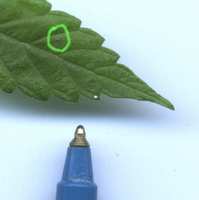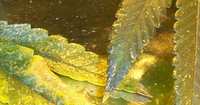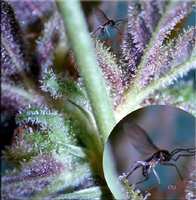Contributed by:
Mr. HIGHway
Submitted:
Images archived
The FAQ
summarizes common indoor insect identification, symptoms
and controls. Refer to pest-specific Faq?s for more
information.
Aphids: Signs of
an infestation: Stunted, curled leaves. Aphids
use piercing mouthparts to suck sap from the Phloem.
Ants often accompany aphids (Ants help transport aphids
around), and will also need to be controlled. Aphids
secrete a sugar-like ?honeydew?, which make the
undersides of the leaves sticky.
How to get
rid of aphids: Use sticky traps (i.e. No Pest
Strip) for prevention and detection. Beneficial insects
like ladybugs can be used to naturally control an
infestation. A soapy spray (i.e. Safer?s Soap or
detergent in warm water) can also be used to suffocate
them.
Summary: ? Suck plant sap
?
Cause stunting, leaf curling
? Leave honeydew
deposits on leaves
? Ants in the grow room
Contributed by:
Sniperman Submitted:
July 24th, 2004
Aphids: symptoms include curled
or yellow leaves. Sticky honeydew residue on leaves,
general weakness in plants.
Control: spray with
a strong stream of water (during veg only). Sticky
yellow traps. Alum foil mulch. Predatory bugs.
Horticulture sprays. Most general-purpose garden spray r
dusts, including pyrethrins, rotenone, and Malathion.
Spider Mites: Signs of an
Infestation: Mites will first be noticed by the
presence of small, discolored spots located near veins
in the leaves. To see them, you will need the help of a
10X loupe, or a 30X Microscope. Mites use piercing
mouthparts to suck sap. Mites will slow growth and
attack the buds in advanced stages. The life cycle of
the spider mite is closely tied to the temperature of
the grow room; slow an infestation by keeping temp in
the low 70?s.
Eliminating spider mites:
A ?No Pest strip? is very effective in eliminating
them. Avid is a very effective systemic chemical
control. A soapy spray will also keep their numbers in
check (thoroughly coat underside of the leaves). Space
plants out to minimize transfer movement between plants.
Summary: ? Suck plant sap
?
'Speckling' may indicate mites underneath
? Mites
may appear transparent, black or red
? 'Bronzing' of
the leaf is characteristic
? Webbing is present in
advanced stages
Thrips:
 |
| Image by Sog: Thrip size
reference |
Signs of an
infestation: Thrips feed on new leaves of plants
(and flowers); fresh leaf growth will deformed. A
metallic sheen on leaves is one sure indicator of
Thrips.
Sog "Thrip feces are easy to see
with the naked eye; they show up as black spots on the
leaves and stems of infected areas. Thrips themselves
are a pale pinkish color."
Controlling
Thrips: Interestingly, Garlic repels Thrips.
Cooler temps will slow down the life cycle, and blue
sticky traps will trap adults. You can siphon them off
by rustling the plant, and sucking them up with a
shop-vac!

|
Image by Sog: Silvered leaves
indicate
heavy attack |
Predator mites
are also beneficial in the control of Thrips. Fine
powdered Sulphur applied to the leaves will control them
as well. A biological spray containing Beauvaria
bassiana, (A fungus that grows and consumes Thrips) is
also effective. Spraying the leaves with Chrysanthemum
also kills Thrips.
Summary: ? Feed on
plant tissue
? Rasp leaf surfaces and suck juices
? Heavily damaged plants appear silvery or gray
? Plants may be distorted, especially seedlings
Whiteflies: Signs of an
infestation: Whiteflies are also sap-suckers.
The top surface of leaves on infested plants become pale
or spotted due to these insects feeding on the
undersides of the leaves. Heavily infested plants will
produce a buzzing cloud of flies if shaken.
The
Whitefly life cycle is interesting in that the larval
stage does all the damage. The larva will hatch and
remain until it has quickly molted 3 times. Then it
pupates and an adult emerges.
Controlling the
Whitefly: Insecticidal soap will take care of an
infestation, as will the more toxic Diazanaon. Apply the
soap (plus a wetting agent) to all parts on the plants,
and both sides of the leaves. This will act to block the
breathing pores and suffocate the pests.
Summary: ? feed by sucking plant
juices
? mottled leaves indicate heavy attack
?
may cause yellowing or death
? excreted honeydew may
cover lower leaves, and black mold may grow on honeydew
Fungus Gnats:
 |
| Image by Ot1: Fungus
Gnat |
Signs of an
infestation: Fungus Gnats are attracted to soils
that are rich in compost and nutrients. They lay eggs on
the surface, hatching into larvae. Those larvae feed on
the root tissue, including root hairs, and the outer
cell covering of the root; often leaving only the
central tube of the root. External signs include
discolored leaves, and systemic plant failure. Fungus
gnat adults will often run across the medium and may fly
if the plant is shaken.
Controlling Fungus
Gnats: Pyrethrum aerosols, as well as placing
yellow sticky traps all around the plant will help
control the emerging adults. Gnatrol (containing natural
Bt) is highly recommended.
Summary:
?Gnats vector root rot
?Gnats on the medium, or
bottoms of the plants
?? long whitish maggots in
the soil
Links to images: naturescontrol.com
tamu.edu
uconn.edu